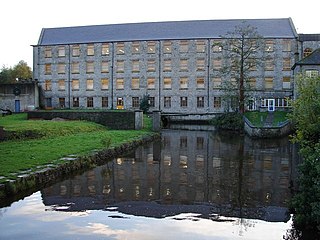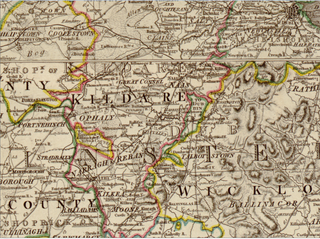
Celbridge is a town and townland on the River Liffey in County Kildare, Ireland. It is 23 km (14 mi) west of Dublin. Both a local centre and a commuter town within the Greater Dublin Area, it is located at the intersection of the R403 and R405 regional roads. As of the 2022 census, Celbridge was the third largest town in County Kildare by population, with 20,601 residents.

Straffan is a village in County Kildare, Ireland, situated on the banks of the River Liffey, 25 km upstream of the Irish capital Dublin. As of the 2016 census, the village had a population of 853, a nearly two-fold increase since the 2006 census.

Kill is a village and parish in County Kildare, Ireland near the county's border with Dublin beside the N7. Its population was recorded as 3,818 people in the 2022 census.

The Kildare County Board of the Gaelic Athletic Association (GAA), or Kildare GAA, is one of 12 county boards governed by the Leinster provincial council of the GAA in Ireland, and is responsible for the administration of Gaelic games in County Kildare. The Lillie's play in the second tier of county football.
Ardclough, officially Ardclogh, is a village and community in the parish of Kill, County Kildare, Ireland. It is two miles (3 km) off the N7 national primary road. It is the burial place and probable birthplace of Arthur Guinness, who is said to have returned to the maternal homestead of the Reads at Huttonread to give birth in the tradition of the time.
County Kildare in the province of Leinster, Ireland, was first defined as a diocese in 1111, shired in 1297 and assumed its present borders in 1836. Its location in the Liffey basin on the main routes from Dublin to the south and west meant it was a valuable possession and important theatre of events throughout Irish history.
Lyons Hill or Lyons is a townland and restored village in County Kildare. At a time when canal passenger boats travelled at 3 mph (4.8 km/h) Lyons was the nearest overnight stop to Dublin on the Grand Canal. On the hilltop is a trigonometrical point used by Ireland's Ordnance Survey. The name derives from the Irish language name for an elm tree, Liamhan.

Oughterard is an ecclesiastical hilltop site, graveyard, townland, and formerly a parish, borough and royal manor in County Kildare, nowadays part of the community of Ardclough, close to the Dublin border. It is the burial place of Arthur Guinness.

Ardclough is a Gaelic Athletic Association (GAA) club in Ardclough, County Kildare, Republic of Ireland, whose biggest achievements include winning the Kildare County Senior Football Championship after a replayed final against the Army in 1949, winning 13 Kildare County Senior Hurling Championships, the latest in 2017 beating Naas in the final, defeating Buffer's Alley in the 1976 Leinster Senior Club Hurling Championship and winning the Leinster Intermediate Club Hurling Championship in 2006. Five Ardclough players featured on the Kildare hurling team of the millennium: Richie Cullen, Tommy Christian, Bobby Burke, Johnny Walsh and Mick Dwane. Bridget Cushen was selected on the Kildare camogie team of the century. Current (2011) Kildare senior hurling panellists are Richie Hoban and Martin Fitzgerald.

Kildangan GAA is a Gaelic Athletic Association club in Kildangan, County Kildare, Ireland, not to be confused with the similarly named Kildangan GAA, based in County Tipperary. The main activity in the club is Gaelic football.
Castledillon is a townland and former parish on the banks of the River Liffey near Straffan, County Kildare in Ireland.
Turnings is a townland in County Kildare, Ireland. It is situated on the banks of the Morell River, a tributary of the River Liffey. It is a rural area between Clane and Straffan.
Castlewarden is a townland, monastic site and former parish situated between Ardclough and Kill, County Kildare just off the N7 in Ireland. The district is home to a golf club and a riding school today.
The Straffan Rail Disaster occurred on 5 October 1853, when a goods train ran into the back of a stationary passenger train one-quarter mile (400 m) south of Straffan station in County Kildare.
Arthur Price was Church of Ireland Archbishop of Cashel from 1744 until his death. Previously he had been Church of Ireland Bishop of Clonfert (1724–1730), Ferns and Leighlin (1730–1734) and Meath (1734–1744).

The High Sheriff of Kildare was the British Crown's judicial representative in County Kildare, Ireland from the 16th century until 1922, when the office was abolished in the new Free State and replaced by the office of Kildare County Sheriff. The High Sheriff had judicial, electoral, ceremonial and administrative functions and executed High Court Writs. In 1908, an Order in Council made the Lord Lieutenant the Sovereign's prime representative in a county and reduced the High Sheriff's precedence. However, the sheriff retained his responsibilities for the preservation of law and order in the county. The usual procedure for appointing the sheriff from 1660 onwards was that three persons were nominated at the beginning of each year from the county and the Lord Lieutenant then appointed his choice as High Sheriff for the remainder of the year. Often the other nominees were appointed as under-sheriffs. Sometimes a sheriff did not serve his full term due to death or another event, and another sheriff was then appointed for the remainder of the year. The dates given in this article are the dates of appointment.

Taghadoe in County Kildare in Ireland is the site of an ancient monastic settlement and round tower. The site includes a graveyard and the ruins of a 19th-century church. It is situated 5 km from Maynooth, off the Straffan Road. The name is derived from Teach Tua or 'House of Tua' in Irish, Saint Tua the abbot of Clonmacnoise, was responsible for founding the monastic settlement here. The site dates back to the 6th century. The round tower was used for about 1000 years, but was left in ruins by the 17th century. Most of the burials in the graveyard were in the 17th and 18th century and it was used by Roman Catholics. A John Dillon of Carton had bequeathed £1,000 for the building of a church on the site; the Duke of Leinster was the executor of his will.
The Lyreen River is a small river in County Kildare, Ireland, a tributary of the Rye River (Ryewater), and ultimately of the River Liffey.
Whitechurch is a village and townland in County Cork, Ireland, about 11 km north of Cork city. It forms part of the Dáil constituency of Cork North Central. As of the 2022 census, Whitechurch village had a population of 719 people.

Saint Anne's Church is a 20th-century Catholic church in Ardclough, Ireland.











